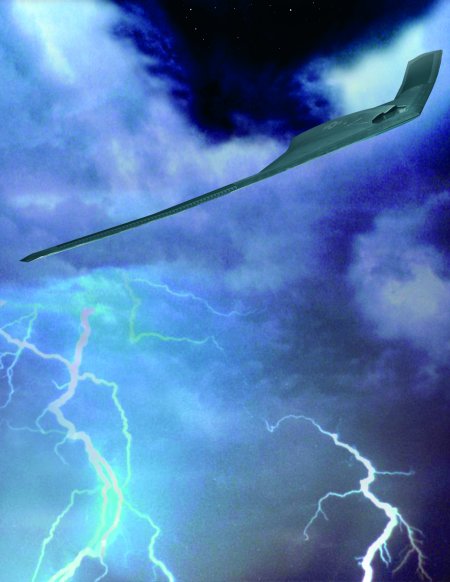Windtunnel testing of aeroelastic model demonstrates ability to control complex bending characteristics in gusts
Active control of wing flexing can allow a high-flying surveillance aircraft to have a long, swept wing that is both aerodynamically efficient and lightweight, Northrop Grumman has demonstrated. The work was conducted under the High Lift-to-Drag Aircraft (HiLDA) portion of the US Air Force Research Laboratory’s SensorCraft project to develop technologies for a future high-altitude, long-endurance unmanned surveillance platform.

Aeroelastic testing of a 12% scale model of Northrop’s 91m (300ft)-span flying-wing SensorCraft concept was conducted in NASA Langley’s transonic dynamics tunnel. The goal was to demonstrate integrated control of aircraft pitch and multiple wing bending modes in response to gusts.
Northrop’s design has a flexible, “minimum-gauge” wing for light weight, which raises issues with bending. “The stiffness of the wing is determined by manufacturing limits; we are not adding composite plies for strength,” says Allen Lockyer, manager, advanced structures development group and HiLDA programme manager.
The company’s B-2 flying-wing bomber has a gust-load alleviation system that reduces wing bending while improving ride quality, the inboard and outboard elevons moving out of phase to control the short-period pitch mode without adding energy to the wing’s first, or simplest bending mode.
SensorCraft’s flexible wing means that multiple “elastic” modes are in the same bandwidth as the aircraft’s “rigid body” response to gusts, and inputs to control pitch could add unwanted energy to wing bending. “For HiLDA, we were able to control the pitch mode and first and second bending modes with a high-order controller,” says Lockyer. Wing-root bending strain was reduced by a factor of two.
The windtunnel half-model had four equally sized trailing-edge surfaces and one on the outboard leading edge. Tests simulated the low-altitude climb-out, where gust intensity is highest. Follow-on tests will look at the high-altitude cruise, where gusts are weaker, but the aircraft is more unstable to reduce drag. The Langley tests also showed that just the outboard leading- and trailing-edge controls could be used, allowing the inboard wing to house sensors.
Northrop also conducted company-funded tests in its own low-speed tunnel of a natural laminar flow aerofoil for SensorCraft. “Using careful passive design we achieved very good laminar flow for a swept wing – over 50% on the upper and lower surface, which is unexpectedly high,” says Lockyer.
Further laminar-flow tests are planned beginning next year under the three-year Aerodynamic Efficiency Improvement programme, an as-yet unfunded follow-on to HiLDA that would be the precursor to a SensorCraft demonstration programme, which could lead to flight tests around 2010.
GRAHAM WARWICK/WASHINGTON DC
Source: Flight International























